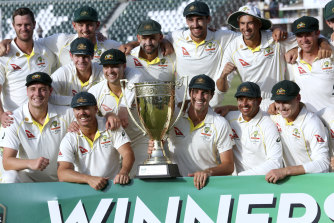Cricket’s contentious $42m bonus scheme to be scrapped
A contentious $42 million performance bonus pool for Australia’s cricketers winning matches and series will be among the first things scrapped when the players and Cricket Australia begin pay negotiations this month.
The performance bonus pool has been in place for a decade, following the recommendations of the 2011 Argus review that brought corporate performance incentives to the contracts of players and staff alike.
Australia celebrate their series victory in Pakistan this year.Credit:AP
However, in the 2018 cultural review of Australian cricket, it came to be seen as emblematic of the “win at all costs” approach that had increasingly been taken by CA, on and off the field, in the leadup to that year’s Newlands sandpaper scandal.
Following the annual conference of the Australian Cricketers Association this week, a set of key principles for pay negotiations were agreed and sent to players. Seen by The Age and The Sydney Morning Herald, they include “embedding cultural change in Australian cricket”.
Shane Watson, president of the ACA, told the players: “We know the partnership model works, but ultimately all the partners in the game would be better served by properly implementing the recommendations from the Longstaff review.”
CA’s chair, Lachlan Henderson, made it clear upon his appointment earlier this year that he and the board would work to implement the review recommendations. These included getting rid of match and series win bonuses, to be replaced with incentives for better behaviour and contributions to Australian cricket culture.
The review recommended: “The current performance bonus (linked to match wins, series wins and world rankings) be converted into a payment, without loss to players current remuneration, in recognition of: Contributions to the maintenance and development of grassroots cricket; Positive relationships with fans, sponsors, etc.”
Another area in which incentives could be directed would be for successful completion of tours like those just undertaken to Pakistan and Sri Lanka.
Players have long railed against the need for additional performance bonuses, arguing that they ran the risk of warping attitudes among players and staff, particularly in terms of longer-term planning. Shortly before his retirement, Ricky Ponting raised questions about the concept in 2012, and reiterated those views on Friday.
“Paying guys to try harder doesn’t make any sense to me,” Ponting said. “You’re out there trying to win every single game, so that financial incentive doesn’t make a lot of sense. I know as a former player, if they offered me an extra amount of money to go out and win a Test match, I can’t see how I could’ve tried any harder, and I’m sure the current players are the same.”
Cricket Australia performance bonus scheme
Total: $42 million available over six years
2021-22 ranking and event bonuses achieved
Men
Topping ICC Test rankings ($1.03 million divided among players)
Winning T20 World Cup ($92,000 divided among players)
Women
Topping ICC ODI rankings ($42,000 divided among players)
Topping ICC T20 rankings ($9300 divided among players)
Winning ODI World Cup ($42,000 divided among players)
Other agreed principles for pay talks include “A simplified and modernised Revenue Share Model”, which would move away from the custom of calculating the players’ fixed percentage of around 26 per cent from only some of the money raised in the game.
This shapes as the most likely area of disagreement between CA and the ACA. As the players’ association chief executive Todd Greenberg conceded last year, there are some revenue areas that players should not be entitled to, such as government grants for infrastructure.
“Clearly there are some revenues that the players aren’t entitled to share,” Greenberg told The Age and The Sydney Morning Herald. “But clearly anything that relates to revenue that has players’ attributes associated with it, then you want the players completely aligned with that. You want the players leaning forward and supporting that in order to grow it.
“To use a really simple phrase, usually you go into an MoU or collective bargaining agreement and the players start by saying ‘what do we want’. I think there’s a way for us to turn this around and say ‘what more can we do, what do you need’ to help grow the sport’.”
News, results and expert analysis from the weekend of sport sent every Monday. Sign up for our Sport newsletter.
Most Viewed in Sport
From our partners
Source: Read Full Article

